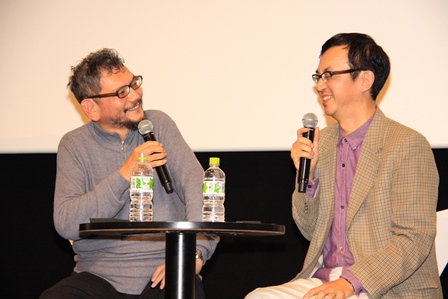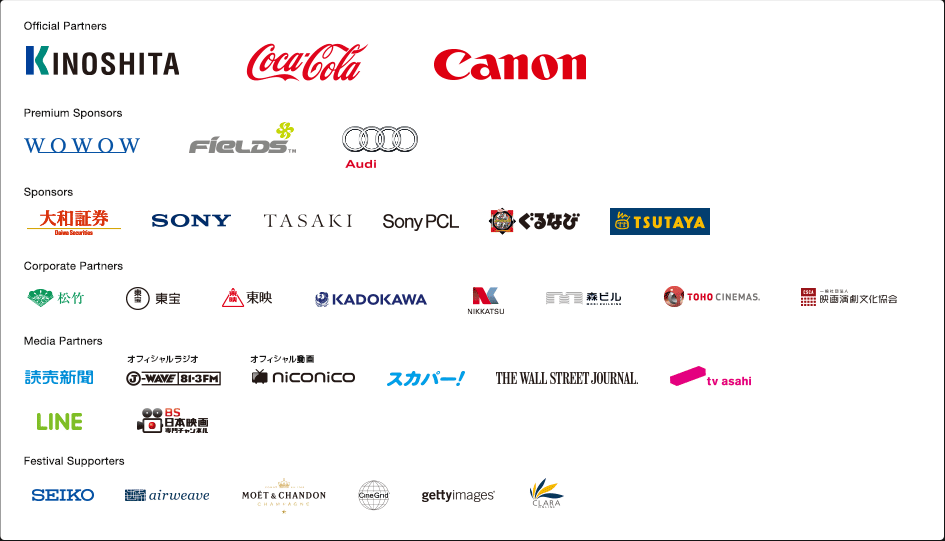
The World of Hideaki Anno
Though Hideaki Anno didn’t invent Japanese anime as we know it, he probably represents the do-it-yourself film aesthetic that characterizes many of its brighter lights better than any of those brighter lights, so it’s only fitting that during TIFF 2014, which is celebrating Japanese animation in grand style, Anno has agreed to sit down and talk about his life as a filmmaker not once, not twice, but several times during the week following screenings of his works.
On Oct. 27, “REVIVAL OF EVANGELION,” an augmented omnibus of several episodes of his “NEON GENESIS EVANGELION” TV series was shown at TOHO Cinemas Nihonbashi, and the huge theater was completely packed with Anno fans. Interestingly, the voluble filmmaker didn’t get to the iconic “EVANGELION” series, which basically made him a star in the 90s beyond his initial cult following, until the very end of the 60+ minute discussion. Most of the talk was about his days struggling with earlier projects that were done for various production companies, a process that impressed on him the importance of a personal vision.
Right away, he wanted to disabuse his listeners of what animation was really about. “It’s not about perfection,” he stressed. “You can never get 100 percent of what you want. Maybe if you’re lucky you get 70-80 percent.” The trick, he said, was “knowing what to discard,” because the temptation is to use everything you create. He learned this lesson the hard way while working on “ROYAL SPACE FORCE,” a sci-fi series in the late 80s, where he was in charge of effects and “mecha design.”
“You learn to get things done,” he said, because essentially you are working with a team that is working for someone else, namely a production company. Though he honed his craft earlier as an animator on films by Hayao Miyazawa and Noboru Ishiguro, it was “ROYAL SPACE FORCE” that showed him the pitfalls of collaborating with a larger entity. He admitted that the first episode he worked on “was terrible.”
His first job as director was on the six-part video series “GunBuster,” which turned out to be a different animal than series made for television. “The budgets tend to be lower,” which meant he had to do something he obviously doesn’t like at all: dealing closely with producers. “It’s why I didn’t like the project and never attended any meetings.” He also had yet to develop a style of his own, and fell back on “mimicking other directors.” Since his specialty was the “hard aspects” of anime–mechanics, visuals–he had yet to think carefully about the softer aspects such as story and characters.
He next worked for NHK on its animated series “NADIA THE SECRET OF BLUE WATER,” which was based on the work of Jules Verne. It was very hard, stressful work, “essentially six months from storyboards to post-production,” he said. He tried injecting his own ideas into the project, much to NHK’s displeasure. When he first moved to Tokyo to attend university in the late 70s, he watched animation on his roommate’s TV, which was black-and-white. “I always thought special effects looked better in black-and-white,” he said, and decided to do one entire episode in monochrome. Since his colleagues had an easier time of it–black-and-white requires less work than color animation–they didn’t complain. “But NHK didn’t like it,” and ended up adding some blue to the finished product. And while he had a hard time, he insists he learned a lot, “especially how to work with time limits.”
On “NADIA” he says he felt “forced into the director’s chair,” and thought the scripts were mostly awful, so in some cases he rewrote them. This would often cause problems because Toho, which was “supporting” the series had already come up with character goods based on the series and if those characters were changed it would mess up their marketing. But that didn’t seem to bother Anno. “I just stopped looking at the screenplays.” In the end, he says he thinks he came up with a series that “didn’t really look like something made by NHK. For one thing the costumers were too sexy. I insisted on showing the character’s belly button.” And though he has some bitter memories of those days, he recently watched the series again and was “impressed.”
“In a way, I got away with a lot at NHK,” he said ruefully, but added that the experience wore him out. It also made him determined to do things his own way from then on, which led to “EVANGELION,” probably his most characteristic work in terms of themes and visuals. “I created it all on my own,” he said proudly. And the best part was that the production company he worked with “liked it, too.” Sometimes the most important thing is to find a partner that believes in you.
























